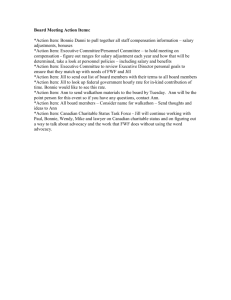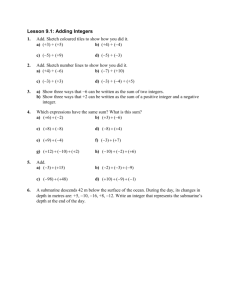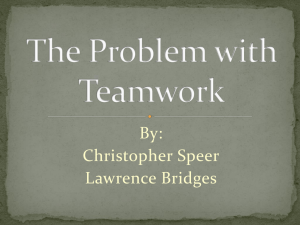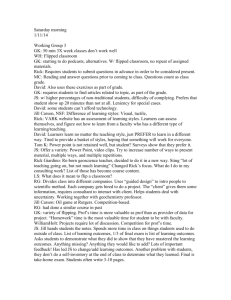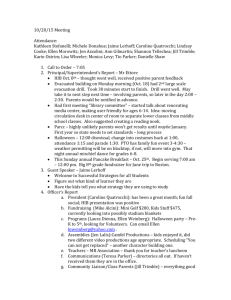functional behavioral assessment
advertisement
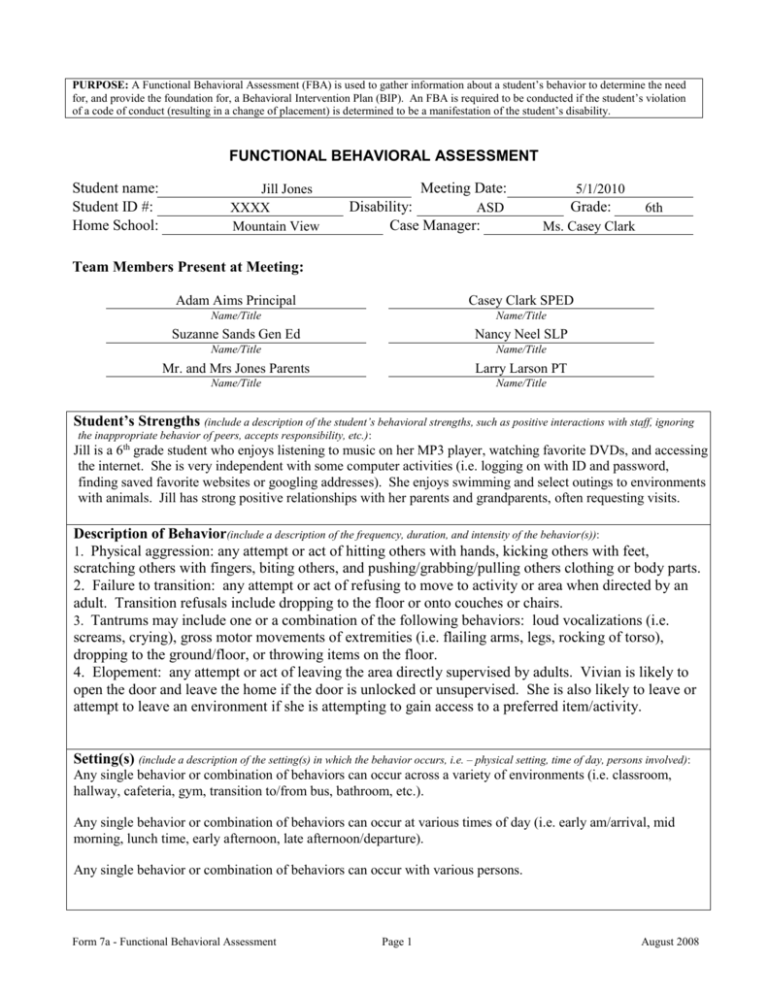
PURPOSE: A Functional Behavioral Assessment (FBA) is used to gather information about a student’s behavior to determine the need for, and provide the foundation for, a Behavioral Intervention Plan (BIP). An FBA is required to be conducted if the student’s violation of a code of conduct (resulting in a change of placement) is determined to be a manifestation of the student’s disability. FUNCTIONAL BEHAVIORAL ASSESSMENT Student name: Student ID #: Home School: Jill Jones XXXX Mountain View Meeting Date: Disability: ASD Case Manager: 5/1/2010 Grade: 6th Ms. Casey Clark Team Members Present at Meeting: Adam Aims Principal Casey Clark SPED Name/Title Name/Title Suzanne Sands Gen Ed Nancy Neel SLP Name/Title Name/Title Mr. and Mrs Jones Parents Larry Larson PT Name/Title Name/Title Student’s Strengths (include a description of the student’s behavioral strengths, such as positive interactions with staff, ignoring the inappropriate behavior of peers, accepts responsibility, etc.): Jill is a 6th grade student who enjoys listening to music on her MP3 player, watching favorite DVDs, and accessing the internet. She is very independent with some computer activities (i.e. logging on with ID and password, finding saved favorite websites or googling addresses). She enjoys swimming and select outings to environments with animals. Jill has strong positive relationships with her parents and grandparents, often requesting visits. Description of Behavior(include a description of the frequency, duration, and intensity of the behavior(s)): 1. Physical aggression: any attempt or act of hitting others with hands, kicking others with feet, scratching others with fingers, biting others, and pushing/grabbing/pulling others clothing or body parts. 2. Failure to transition: any attempt or act of refusing to move to activity or area when directed by an adult. Transition refusals include dropping to the floor or onto couches or chairs. 3. Tantrums may include one or a combination of the following behaviors: loud vocalizations (i.e. screams, crying), gross motor movements of extremities (i.e. flailing arms, legs, rocking of torso), dropping to the ground/floor, or throwing items on the floor. 4. Elopement: any attempt or act of leaving the area directly supervised by adults. Vivian is likely to open the door and leave the home if the door is unlocked or unsupervised. She is also likely to leave or attempt to leave an environment if she is attempting to gain access to a preferred item/activity. Setting(s) (include a description of the setting(s) in which the behavior occurs, i.e. – physical setting, time of day, persons involved): Any single behavior or combination of behaviors can occur across a variety of environments (i.e. classroom, hallway, cafeteria, gym, transition to/from bus, bathroom, etc.). Any single behavior or combination of behaviors can occur at various times of day (i.e. early am/arrival, mid morning, lunch time, early afternoon, late afternoon/departure). Any single behavior or combination of behaviors can occur with various persons. Form 7a - Functional Behavioral Assessment Page 1 August 2008 Antecedent(s) (include a description of the relevant events that preceded the behavior): Any challenging behavior or combination of behaviors may be predicted by setting events (slow triggers) or a combination of setting events and direct antecedents (fast triggers). Below is a list of potential setting events and antecedents that may predict behavior. Any adult interacting with Vivian should review the list and follow antecedent strategies to prevent challenging behavior. 1. Hunger/Thirst 2. Fatigue (tired) 3. Confusion 4. Changes in routines 5. Asked to wait 6. Told “no” 7. Unfamiliar environments 8. Non preferred activity 9. Unfamiliar people Consequences and Educational Impact (include a description of the result of the behavior (i.e. – removed from class, not able to complete assignments/tests, etc.), and the impact on the student, peers, and the instructional environment): When Jill engages in challenging behaviors the result is dependent upon the level (intensity and duration). A low level behavior can typically be redirected within a short amount of time (3-10 minutes) and is mildly disruptive to other students or persons in class/environment. A low level behavior interferes with the completion of a task or transition for a short time, but Jill will then follow through. A higher level behavior that cannot be redirected or deescalated within 30 minutes will disrupt a classroom/environment and result in a removal of Jill to a quiet space for de-escalation. She often cannot reenter the class or activity for a length of time (45 minutes to several hours). Levels of behavior are defined on the data collection form. Other Potential Variables (include a description of any other factors/variables that may affect the behavior, such as medication, weather, diet, sleep, substance abuse, attendance, social factors, etc.): 1. Onset of puberty: Jill began her menses cycle in March, 2010. 2. Jill has several food sensitivities and is Gluten and Casein free. Mrs. Jones reports an increase in challenging behaviors if she has ingested foods with Gluten or Casein, therefore all adults working Jill should monitor her food intake in all settings. 3. Jill has a history of digestive problems. She has long periods of constipation which have a negative impact on her behavior. 4. Emotional fragility: Jill’s emotional states are linked to levels of anxiety and obsessive compulsive tendencies (documented and supported by family neuropsychiatrist—see cumulative file). They can fluctuate significantly from day to day (i.e. high pitched screams, flailing arms and body, crying and agitation, etc.). 5. Jill has significant sleep abnormalities—parents report she often sleeps less than 3 hours on any given night. 6. Jill experiences pain related to her orthopedic abnormalities. She has recently been holding the side of head and abdomen with her hand to indicate discomfort. Form 7a - Functional Behavioral Assessment Page 2 August 2008 Prior Interventions (include a description of the behavioral interventions that have been implemented in the past, including the date(s) of implementation, length of intervention, the impact of the intervention on the student’s behavior, etc. Attach data summary, if appropriate): 1. 2. 3. 4. PECS—some success, but not easy to find/use. Visual schedules—some success, but often not available (i.e. gym, cafeteria, etc.). Frequent breaks—a difficult time getting her back to tasks. Reward system—a difficult time for Jill to give up the activity/item. No data Hypothesis of Behavioral Function (describe the team’s hypothesis of the relationship between the behavior and the environment in which it occurs – what function is this behavior serving for the student? What is the student trying to get? What is he/she trying to avoid?): 1. Jill is likely to engage in physical aggression to others in an attempt to gain access to a preferred activity that has been denied or postponed. 2. Jill is likely to engage in physical aggression to others in an attempt to escape/avoid a demand or non preferred activity. 3. Jill is likely to engage in transition refusal behavior in an attempt to gain access to preferred activity that has been denied or postponed. 4. Jill is likely to engage in transition refusal behavior in an attempt to escape/avoid a demand or non preferred activity. 5. Jill is likely to engage in elopement behavior in an attempt to gain access to a preferred activity that is present in the environment, has been denied or postponed. 6. Jill is likely to engage in elopement behavior in an attempt to escape/avoid a non preferred setting. 7. Jill is likely to engage in tantrum behavior in an attempt to communicate frustration based on her confusion in any given situation. For example, if an adult is responding to her request for an item out of the refrigerator and the adult takes out an item that Jill was not expecting she will begin to tantrum (i.e. whine, pull/push item from hand). Then tantrum behaviors are typically a second behavior in a chain (i.e. transition refusal, physical aggression, elopement will precede tantrumstherefore the function of the first behavior should be targeted for intervention). Form 7a - Functional Behavioral Assessment Page 3 August 2008 Summary/Recommendations (Provide recommendations for prevention of the target behavior, replacement skills/behavior(s) to be taught, reinforcements for positive behaviors, etc.): Antecedent Strategies: The following antecedent strategies will be implemented in order to prevent or reduce the likelihood of Jill engaging in challenging behaviors. 1. Provide a consistent and predictable routine for Jill. If the routine is altered adults will need to inform Jill of the change using a pictoral schedule. Jill will likely engage in a challenging behavior if a change occurs, at this time staff should follow strategies for teaching replacement behaviors and consequence strategies. 2. Use clear, concise language when giving Jill directions or information. For example, rather than string several sentences together, use a simple First/Then format. “First work, then toast”. A First/Then visual support will be used to provide Jill with static information about the expectations. 3. Ensure the direction or information is given after you have Jill’s attention (i.e. she is not looking at Video or has her back toward adult). 4. Jill will have access to her communication device across the day. Encourage her to use her device to communicate her needs/desires (see IEP goal for specific teaching criteria). 5. Ensure Jill’s expectations are not overwhelming. For example, if she has a Dr. appointment at 12:00 it may be helpful to reduce her expectations in the morning to ensure her anxiety level remains low (i.e. rather than working on 3 different tasks have her work for a shorter duration and include longer breaks). Adults working with Jill will need to have knowledge of upcoming events so they can plan accordingly. Events include Dr. appointments, community outings, consults from educational team, etc. 6. Allow Jill time to process information. In general allow a minimum of 30 seconds (or up to 1 minute if she is engaged in a highly preferred activity) before restating instruction or redirection. Jill may also need extra time to complete ritualistic behavior prior to the transition (i.e. put video back in case, straighten area, etc.). 7. Maintain appropriate “position”, “attention”, and “participation” expectations for Jill. These expectations are further described in Teaching Strategies. 8. Monitor Jill’s basic needs at all times (hunger, thirst, sleep, general health, etc.). Jill is likely to engage in challenging behaviors when her basic needs are not met. Frequent snacks are critical. If the communication log reports low sleep, it will be necessary to allow a short nap mid morning (about 30 minutes). 9. Provide Jill with a schedule/routine/expectations that allows for break opportunities. Jill is increasing her ability to maintain active engagement across various activities, but she functions more appropriately when frequent breaks are given. The break schedule should be based on the intensity of the demands that precede the break. For example, after Jill arrives at school she takes a break with her videos (i.e. remember that transitions are difficult), after she completes her hygiene routine and has breakfast she will take another break (i.e. several transitions and directions to follow), and if she is being engaged in more cognitive/academic demands it may be Form 7a - Functional Behavioral Assessment Page 4 August 2008 necessary to provide a break after 20-30 minutes. Jill is working on increasing her engagement and participation in leisure activities instructional tasks. 10. Rotate/vary activities to ensure Jill’s interest remains high. Teaching Strategies: Jill will learn the following skills in order to replace the existing challenging behaviors with more appropriate forms of behavior that allow her to communicate more effectively or access the same function. 1. Jill will remain in “position” at all times throughout the day. a) Sitting position: Jill will learn to sit in her chair with appropriate posture (feet on floor, hands down). An appropriate sitting position will decrease Jill’s opportunities to grab, throw or clear items from a table and decreases the likelihood of elopement from the seated area. An appropriate sitting position will increase Jill’s attention to task and adult directives. b) Standing position: Jill will learn to stand in one place with her hands at her side. An appropriate standing position will decrease the likelihood that Jill will elope from the area and decrease the likelihood that she will grab items that are not available. An appropriate standing position will increase Jill’s attention to the task and adult directives. c) Walking position: Jill will learn to walk next to an adult, without running ahead or lagging behind. An appropriate walking position will decrease the likelihood that Jill will elope from the adult and decrease the likelihood that she will grab items that are not available. An appropriate walking position will increase the success of appropriate transitions across environments. 2. Jill will learn to use her communication device to appropriately communicate her needs/desires. a. Provide Jill access to her communication device at all times. b. Ensure the device is plugged in or the batteries are charged. c. The communication device should be appropriately programmed (i.e. symbols, pages, requests, negations, etc.) and updated as necessary. d. If Jill begins to communicate by pulling/pushing an adult direct her to the communication device and state, “tell me what you want”. Provide gesture prompts as appropriate. e. If Jill begins to engage in a challenging behavior direct her to the communication device and state, “what do you need/want”. If she requests an activity that is not available the adult will need to use a First/Then statement. Example: an adult has directed Jill to complete a puzzle and she drops to floor and begins to whine. The adult gives her the device and she asks for “DVD player and blanket”. State to Jill, “first puzzle then DVD and blanket”. Adults should follow through with the original expectation when the environment allows. For example, if Jill is in a structured learning environment that can be controlled the adults should follow through with the original expectation of completing the puzzle before giving her access to an alternate activity or the DVD player and blanket. If, however, Jill is in a less Form 7a - Functional Behavioral Assessment Page 5 August 2008 structured/less controlled environment it may be necessary to redirect her with an alternate activity or the requested item to ensure Vivian’s safety and the safety of others. f. Set up opportunities across the instructional day to encourage Jill to manipulate her device (i.e. use different symbols, access multiple pages, etc.), see IEP for specific criteria. 3. Jill will learn to “wait” for a preferred item/activity or to move/transition. a) Set up opportunities across the instructional day to encourage Jill to “wait” for increasing longer periods of time. Example: Jill has asked for her DVD player. State, “first wait, then DVD”. Initially the wait time will be short (10-20 seconds). Overtime adults will systematically increase the wait time. A timer is helpful to provide Jill a cue. b) Adults will work on waiting in a controlled environment before expecting Jill to wait in less controlled environments 4. Jill will learn to transition appropriately across a variety of settings (i.e. functional transitions in the community, transitions to less preferred activities, and transitions away from preferred activities). a) Jill will independently transition to a non preferred or less preferred activity in a controlled environment (leaving preferred activity). Controlled environments include structured learning environments where elopement opportunities are limited and adults can control the level of structure and activities. Examples include: transitioning from work area to bathroom for hygiene routine, from bathroom to kitchen for meal prep/eating routine, and from engaging in preferred activity such as watching movies to a less preferred activity such as engaging in other leisure activities or instructional tasks. b) Jill will independently transition during higher preferred activities that occur in less controlled environments. Less controlled environments that target higher preferred transitions will provide an increased level of success for Jill (i.e. she will be more likely to have a successful transition if she is going to an activity/setting that has a reward value). Examples of less controlled environments include transitions to/from cafeteria, community outings such as swimming, etc. c) Jill will independently transition during lesser preferred or non preferred activities that occur in less controlled environments. Examples of less controlled environments include transitions to/from bus, hallways, PE, community outings, etc. Positive Consequence Strategies (Positive Reinforcement): The following consequence strategies summarize positive reinforcement to increase the likelihood that Jill will engage in appropriate behaviors or decrease the likelihood that she will engage in challenging behaviors. 1. Provide Jill with continuous access to her communication device to ensure she can appropriately and effectively communicate her needs/desires. 2. Provide Jill with contingent positive reinforcement activities/items across the instructional day. Form 7a - Functional Behavioral Assessment Page 6 August 2008 Current reinforcement activities include accessing DVD player and preferred movies, some edibles (chocolate chips, potato chips—diet friendly), and escape from environments or people that are paired with demands. Jill does have other activities/items that she may occasionally access, but are not directly linked to “increasing the likelihood that she will engage a target behavior”. These items include, but are not limited to: toys/fidgets that have some resistance and make noise, visual fidgets that provide a sensory experience, toys that represent preferred characters (Kermit, Miss Piggy, etc.), and some computer activities. Reactive Consequence Strategies: The following consequence strategies summarize reactions to respond to Jill if she engages in in challenging behaviors. 1. If Jill engages in physical aggression adults should: a) Move out of Jill’s reach. b) Remove objects (i.e. furniture, work items, etc) from Jill’s reach. c) If in a controlled environment redeliver instruction. If not in a controlled environment see step j). d) Give Jill access to her communication device (may need to be limited if she is escalated and likely to damage the device). e) Use clear, concise language (i.e. First/then, “Its time to ____”). f) Redeliver instruction, using clear, concise language (i.e. Jill it is time to finish puzzle, First puzzle, then DVD) about every 3-5 minutes. g) If the physical aggression continues block her attempts, move out the way of the aggressions, and have her sit on the floor if she is standing. h) Once Jill is calm and able to maintain standing or sitting position redeliver the instruction. i) Provide her with behavior specific praise (i.e. Jill you are following directions to sit down). j) If Jill continues to engage in aggression and you are in a less controlled environment, attempt redirection/distraction techniques; if necessary, use physical manipulation as the last option (i.e. support Jill at elbows to move toward safe area). Use of physical manipulation should only be used if Jill is a physical threat to herself or to others, or in a dangerous situation (i.e. traffic, near glass door, etc.). Adults should only move Jill far enough to be safe (i.e. out of crosswalk vs. to the car, away from the glass door vs. out of the room/building, etc.). 3. If Jill engages in a failure to transition adults should: a) Allow time for Jill to process the information regarding the transition (give up to 3-5 minutes). b) Assess if Jill needs the transition broken down into smaller steps (i.e. DVD player off, stand up). c) Assess if Jill needs additional information about the transition (i.e. First/then statement, Form 7a - Functional Behavioral Assessment Page 7 August 2008 “Time to _____” gestural prompt, etc.). d) If Jill is engaged in a preferred activity and she does not independently end that activity, remove access to the activity (i.e. turn off DVD player). e) Provide Jill access to her communication device. f) If Jill continues to refuse to transition, and you are in a controlled environment, redeliver the instruction about every 3-5 minutes. If she engages in physical aggression follow the steps for responding to physical aggression. g) If Jill continues to refuse to transition, and you are in a less controlled environment, attempt redirection/distraction techniques; if necessary, use physical manipulation as the last option (i.e. support Jill at elbows to move toward safe area). Use of physical manipulation should only be used if Jill is a physical threat to herself or to others, or in a dangerous situation (i.e. traffic, near glass door, etc.). Adults should only move Jill far enough to be safe (i.e. out of crosswalk vs. to the car, away from the glass door vs. out of the room/building, etc.). 4. If Jill attempts to elope or elopes: a) If the elopement has been initiated the adult will need to get in front of Jill. She will not respond to verbal directions alone if she has initiated the elopement. b) Direct her back to the appropriate position (i.e. standing, sitting, walking). c) If Jill does not stop or pushes past, gently assist her to sit down. d) Provide Jill access to her communication device. e) When Jill is calm, direct her to a standing position and continue with original direction or transition expectation. Crisis Management: If Jill engages in physical aggression, tantrum behavior or failure to transition adults should follow the guidelines stated above regarding consequence strategies. If Jill’s behavior is intense enough to cause injury to herself or others adults will: 1. Determine if medical assistance is needed, if so, call 911. 2. Contact Jill’s parents to inform them of the injury. 3. When the situation has deescalated the adults will need to document the injury (i.e. injury form, picture of injury). 4. When intervention strategies have been implemented and Jill continues to engage in high rates/intense behaviors for significant duration of time (i.e. several hours, across several days), or if Jill develops a new behavior that needs to be targeted for intervention, a meeting will be held to determine next steps. Form 7a - Functional Behavioral Assessment Page 8 August 2008 Form 7a - Functional Behavioral Assessment Page 9 August 2008
